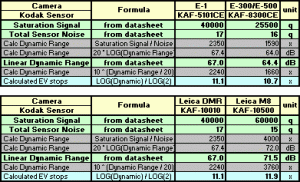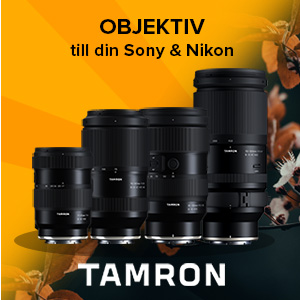Re: Vielen dank für alle intressante antworten
Hello IT Sundvisson,
Sundvisson skrev:
Hallo Anders Uschold,
Sorry that with my propeller hat on, most of my speculative questions were spinning around sensor architectures. Still, I found your answers informative and I am appreciating both your experienced answers and for taken the time to answer those questions here.
Thank you very much. It is my pleasure. In some German communities people feel, they have the absolute right to get answers for all of their questions, no matter how much time the "interrogated" spends or whether he touches some confidential aspects.
Therefore I appreciate your words!
Sundvisson skrev:
I understand that capturing the photons is an important step in the beginning of the image flow, which gives i.e. the mentioned F30 a good start.
So patents, like the lens mount, is a way for several vendors to survive in their own sandbox, in the larger playfield. As long as some key benefits exist for each vendor, it is enough to keep them surviving. You can patent implementations, but not the idea, like we are seeing at least with three different CCD-shift in-body image stabilization techniques.
This is an excellent example: The idea to stabilise by shifting the sensor is free. But the drive technology isn't. This detail is extremely interesting, as it shows many tradeoffs of technolgies. The driving technology of a sensor is highly related to the driving technology of an AF-motor:
1. Fastest and most precise are piezo-ceramic drives, known as "ultrasonic" or AF-S or HSM. In reality this is a pure marketing word, ultrasonic waves don't occur anywhere in those lenses

. The disadvantage of this technology are less sturdiness and mechanical wear. The ceramic surfaces show abrasion during long term use and loss accuracy and reliability. KonicaMinolta and Sony feauture piezo ceramic drives as well as the lens manufacturers mentioned above.
2. Second and most converntional are magnetic spin drives, that are used by Olympus in sensor stabilisation and lens drives. This technology is slower but shows less mechanical wear.
3. Magnetic position is used by Pentax/Samsung to do their sensor drive. This technology is contactless and therefore shows now mechanical wear or deterioration at all. But we have no experience of power consumtion, speed and interference of these extremely strong permanent magnets around the sensor with their environment.
Me by myself, I would not wear a mechanical watch
on my wrist, while holding one of these cameras *lol*.
Sundvisson skrev:
You are mentioning image processing performance. Will we still rely on the JPEG, or are other picture standards on the horizon within say the next decade ? There's sometimes talk about dynamic range limitations of JPEGs, especially when we now see cameras improve on this parameter. Will still the raw files be kept as company proprietary? Or will raw files become less important over the next years, when Out-Of-Camera image quality improves. (I'm using raw files more for adjusting the exposure and contrast, and less for WB adjustments. So a larger latitude of my JPEG, could reduce the need for using raw files.)
The truth about JPEG and its amazing persistence is pricing: JPEG 2000 proved to be much better, but the inventors asked for license fees. Therefore the whole industry ignored the quality aspect and prefered the economical aspect. To be fair, I do not assume, that there haven't been some who thought about switching to the better standard. But it is enough, if just one or two global players keep with the free old JPEG. They would gain an advantage in price competition and the result for the "sincere brands using JPEG 2000" would have been to loose market share. The horrible truth is, that the common user doesn't care for quality, he cares for money.
Regarding dynamic range: People and companies often rely on the sensor's or A/D converter's dynamic range. This doesn't meet reality. A lens has a dynamic range too. Imagine a global flare, = homogenous mist all over the image caused by internal reflections and diffusion, of 0.5 %. This is 1/200 or something like 1 / 2^8. That represents a limitation of 8 stops or 48 dB. Well, lens flare is additive to scene signals, so the shadows of an projected image will not be cut, but softened. But we often see, that a poor lens limits a camera's input dynamic range significantly. BTW that's not new, with film only excellent lenses provided brilliant images of black shadows and bright highlights

.
A comparison of the Fuji S3Pro showed:
- 8.7 stops using the Nikon 18-70 3.5-4.5
- 9.0 stops using the Nikon 60 2.8 Micro
Both are good lenses, but a prime lens often features less elements and therefore higher flare
performance.
Sundvisson skrev:
I read with interest a test just published in GP (Göteborgs-Posten), that your company has produced for them. Here the long-zoom cameras were tested. Are we still going to see the pixel-race continue? I just read about a 1/1.8" Foxconn 12 megapixel DS-C350 digital camera, aren't we seeing any effects of diffraction yet? Or is diffraction hidden in the available resolution of the lenses and also disguised in the processing?
From the technical point of view, the pixel race is already over with the small compacts. They are limited by diffarction and only raise in noise. And ALL engineers from the big brands know for that. My advise is: buy a 7 megapixel compact - don't touch a 10 Mp and even don't glance at 12 MP or higher.
The problem is the marketing trap all companies are cought in. They promoted pixel numbers for years and years. How to explain the senselessness and the limitation of the universe, = optical diffraction, to the "stupid" customer. Well they have been made stupid by customizing them to simple numbers like Pixel. What do you think is the maximum resolution of all those 2400 to 9600 dpi printers on paper? We found 400 dpi an excellent mark, somthing like 600 dpi is our current high score. And almost all flatbed scanners don't provide more than 800-1200 dpi just in the sweet area - no matter how much they claim.
Sundvisson skrev:
Among the dSLRs, I expect the Four-Thirds mount will be the first to be affected by diffraction. How limiting is diffraction in current dSLRs on the market?
You are right in theory - 4/3 suffers from earlier diffraction than APS. But on the other hand, the smaller sensor and the complete change to a new concept away from the 35-mm mount restrictions, enabled them to harmonise lens pupils, sensor specs and microlens shifting entrance pupil. The smaller sensor diameter also allows to built faster maximum aperture.
These conditions allow to build lenses of "open-aperture-performance" at an affordable price. The usable or preferable aperture range is limited by open aperture restrictions at the front and diffraction at the more closed apertures. If a lens faces diffraction by 1:9.5 already, but provides high performance from aperture 1:2 on, it beats a lens that features high performance from aperture 1:4 to 1:11. No matter if this lens has a soft maximum aperture of 1:2.8 or 1:2.
Regarding film, the problem of diffraction and limited aperture ranges are equivalent. These lenses haven't been better performance. The problem of digital photography is the so called "new visiblity" of limitations. Who of you possess' a 20x magnifying loupe and spent his time by examining slides on your light table? But today this examination is just a <ctrl+0>-click away

.
When we tested medium format format lenses with more than 20 Megapixel, the thing we found was optical limitations. So don't worry for the pixel count. 10 - 12 is enough from my point of view.
to be continued ..










